1. Trust among participants
Being an emerging technology, organizations have trust concerns about the safety of the technology in safeguarding their health data and user transactions.
Every transaction in the blockchain is essentially secure and verified; this is true even though there is no central authority present to validate and verify transactions.
There are also concerns about other participants on the network, as while health organizations can work together on the same platform to enjoy interoperability and access to data from other organizations, they are often competitors.
Health organizations often opt for private and consortium blockchain networks where access is permissioned and all participants involved are known and verified before being given access.
2. Interoperability
While blockchain aids interoperability, this is currently possible for participants on the same blockchain network.
There are no standards accepted around the world for the design of blockchain networks; hence, different networks might not be interoperable, the lack of which would impact their adoption, especially in healthcare, where health data is frequently shared among health organizations.
As technology advances and more and more organizations develop their blockchain projects, interoperability across different networks is achievable.
3. Uncertainty In Storage Capability
Health data is big data, from patient history to test results, treatment plans, radiological images, etc.
This large volume of data for every patient in a health organization is a lot of data.
Considering the distributed nature of blockchain, every participant on a network would have an updated copy of the large data set of patient records.
This would surely require huge storage capacity to ensure the network functions effectively.
4. Need for wide adoption for effectiveness
Blockchains require wide adoption to be effective in their applications, without which their scalability will be limited.
To take advantage of the benefits of blockchain technology, all stakeholders involved must adopt it in their operations.
An example is the case of drug supply chains, where pharmaceuticals and clients must make use of blockchain to enjoy its immutable record-keeping feature and stay ahead of counterfeit drugs.
5. Lack of skilled developers
Blockchain technology is still very much a new technology, and the skills needed to develop and adopt it on an enterprise level are in short supply.
The marketplace for blockchain developers has therefore been competitive, with available developers opting for the highest-paying jobs.
To combat this, businesses and even those on a budget opt for Blockchain-as-a-service (BaaS) to take advantage of blockchain in their operations.
BaaS is a cloud service model that offers blockchain development tools in the cloud, which enables organizations to reap the benefits of blockchain without having to invest significantly in the underlying technology.
This way, businesses only need to know the basics of the technology to build blockchain projects and don’t need to be developers to take advantage of its benefits.
6. Data privacy and regulations
Blockchain, being a new technology, is yet to be captured in data privacy laws and regulations in most parts of the world.
The healthcare industry is a sensitive industry where organizations cannot adopt new technologies with little to no research-backed safety index in handling patient data, which can pose a threat to patient data safety and privacy.
Common privacy regulations only allow health organizations to process patient data in their care after approval from the patient.
The distributed nature of blockchain offers other health organizations in the network access to patient data that is not primarily in their care, hence breaching common privacy laws, whether for a beneficial intent or not.
Organizations would have to wait for regulations to catch up with blockchain technology to appropriately adopt it in healthcare.
7. Environmental affectation
Blockchain verifies data transactions and secures the network using consensus mechanisms, which is an energy-intensive activity.
The largest chains in the world, however, not in healthcare—Bitcoin and Ethereum—have proven records of high energy consumption needed for computers to undergo consensus mechanisms.
This is a real issue that adversely affects the environment.
These blockchain networks are currently making moves to switch to more sustainable energy sources.
For an industry-wide adoption of blockchain in healthcare, these concerns must be considered, as must the sustainable energy source involved.
8. Security
While blockchains are nearly impossible to hack, and they get harder to hack the bigger they become, there are still some ways hackers can harm users.
Hackers often deploy phishing schemes to lure users into giving away access codes to their blockchain accounts or wallets, where these hackers can access health data and manipulate it as they please.
Also, dApps built on top of blockchain technology are sometimes vulnerable to sophisticated hacking.
Obisesan Damola
Damola is a medical doctor who has worked in the Nigerian healthcare industry for a little over 3 years in a number of primary, secondary, and tertiary hospitals. He is interested in and writes about how technology is helping to shape the healthcare industry. He graduated from the College of Medicine, University of Ibadan, the foremost medical training institution in Nigeria.



